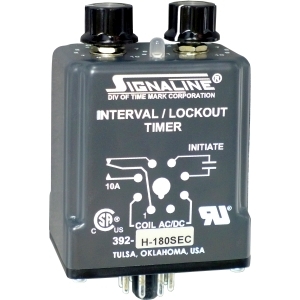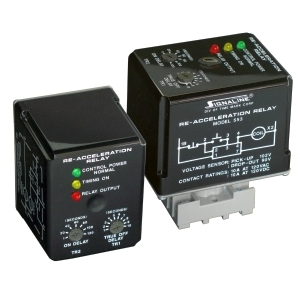-
392-L-10SEC
Interval/Lockout Timer1 - 10 Sec.Select optionsThe Model 392 Interval Lockout Timer is useful when you wish to de-energize the relay for a set period of time. Power is applied to the coil all the time. The Dry contact must close the initiate switch and re-open to energize the relay for the On time setting. At the end of the On time, the relay will de-energize and remain de-energized for the lockout time period. Closing and re-opening the initiate switch during the timing has no effect on the operation of the relay. At the end of the Lockout time the relay can be operated as before. An SG version of this model is available using silver with gold flash contacts.
The Model 392 is UL Recognized and CSA Certified.
-
392-L-180SEC
Interval/Lockout Timer1 - 180 Sec.Select optionsThe Model 392 Interval Lockout Timer is useful when you wish to de-energize the relay for a set period of time. Power is applied to the coil all the time. The Dry contact must close the initiate switch and re-open to energize the relay for the On time setting. At the end of the On time, the relay will de-energize and remain de-energized for the lockout time period. Closing and re-opening the initiate switch during the timing has no effect on the operation of the relay. At the end of the Lockout time the relay can be operated as before. An SG version of this model is available using silver with gold flash contacts.
The Model 392 is UL Recognized and CSA Certified.
-
392-L-300SEC
Interval/Lockout Timer1 - 300 Sec.Select optionsThe Model 392 Interval Lockout Timer is useful when you wish to de-energize the relay for a set period of time. Power is applied to the coil all the time. The Dry contact must close the initiate switch and re-open to energize the relay for the On time setting. At the end of the On time, the relay will de-energize and remain de-energized for the lockout time period. Closing and re-opening the initiate switch during the timing has no effect on the operation of the relay. At the end of the Lockout time the relay can be operated as before. An SG version of this model is available using silver with gold flash contacts.
The Model 392 is UL Recognized and CSA Certified.
-
392-L-60SEC
Interval/Lockout Timer1 - 60 Sec.Select optionsThe Model 392 Interval Lockout Timer is useful when you wish to de-energize the relay for a set period of time. Power is applied to the coil all the time. The Dry contact must close the initiate switch and re-open to energize the relay for the On time setting. At the end of the On time, the relay will de-energize and remain de-energized for the lockout time period. Closing and re-opening the initiate switch during the timing has no effect on the operation of the relay. At the end of the Lockout time the relay can be operated as before. An SG version of this model is available using silver with gold flash contacts.
The Model 392 is UL Recognized and CSA Certified.
-
553-01
Re-Acceleration RelaySelect optionsThe Model 553-01 Re-Acceleration Relay is designed to take the place of a voltage sensing relay and two time delay relays. When voltage is applied to the Model 553-01, and the external start switch is closed, the adjustable on-delay time begins. After the delay period, the contacts will close. If the line voltage drops below 90 volts, the contacts open and the true-off delay begins. If the voltage rises above 105 volts before the true-off delay has elapsed, the contact will re-close. If voltage is not restored to 105 volts before the true-off delay time period ends, the contacts will remain open until the external start switch is closed.
-
553-02
Re-Acceleration RelaySelect optionsThe Model 553-02 Re-Acceleration Relay is designed to take the place of a voltage sensing relay and two time delay relays. When voltage is applied to the Model 553-02, and the external start switch is closed, the adjustable on-delay time begins. After the delay period, the contacts will close. If the line voltage drops below 90 volts, the contacts open and the true-off delay begins. If the voltage rises above 102 volts before the true-off delay has elapsed, the contact will re-close. If voltage is not restored to 102 volts before the true-off delay time period ends, the contacts will remain open until the external start switch is closed.
-
553-03
Re-Acceleration RelaySelect optionsThe Model 553-03 Re-Acceleration Relay is designed to take the place of a voltage sensing relay and two time delay relays. When voltage is applied to the Model 553-03, and the external start switch is closed, the adjustable on-delay time begins. After the delay period, the contacts will close. If the line voltage drops below 90 volts, the contacts open and the true-off delay begins. If the voltage rises above 102 volts before the true-off delay has elapsed, the contact will re-close. If voltage is not restored to 102 volts before the true-off delay time period ends, the contacts will remain open until the external start switch is closed.
-
553-04
Re-Acceleration RelaySelect optionsThe Model 553-04 Re-Acceleration Relay is designed to take the place of a voltage sensing relay and two time delay relays. When voltage is applied to the Model 553-04, and the external start switch is closed, the adjustable on-delay time begins. After the delay period, the contacts will close. If the line voltage drops below 90 volts, the contacts open and the true-off delay begins. If the voltage rises above 102 volts before the true-off delay has elapsed, the contact will re-close. If voltage is not restored to 102 volts before the true-off delay time period ends, the contacts will remain open until the external start switch is closed.
-
553-05
Re-Acceleration RelaySelect optionsThe Model 553-05 Re-Acceleration Relay is designed to take the place of a voltage sensing relay and two time delay relays. When voltage is applied to the Model 553-05, and the external start switch is closed, the adjustable on-delay time begins. After the delay period, the contacts will close. If the line voltage drops below 90 volts, the contacts open and the true-off delay begins. If the voltage rises above 102 volts before the true-off delay has elapsed, the contact will re-close. If voltage is not restored to 102 volts before the true-off delay time period ends, the contacts will remain open until the external start switch is closed.
Timers
Below you'll find a list of all items that have been categorized as “Time-Delay-Relays”


